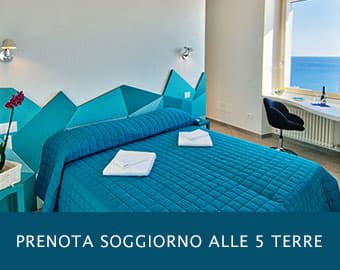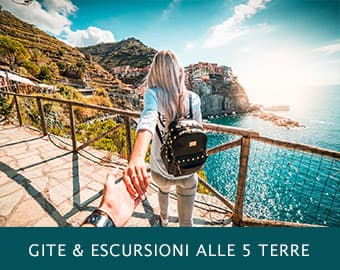Recommended
by CinqueTerre.com
 La Spezia is the provincial capital within which the Cinque Terre and the villages of the Golfo dei Poeti are located, the richest city center of accommodation facilities where you can stay to reach the surrounding countries by train, car, bus or boat. Located in the far east, on the border with Tuscany, the city lies at the end of its deep and natural gulf that has made it highly strategic from a maritime and military point of view. La Spezia is closed behind by hills that gradually become higher and less built up to the highest height of Mount Parodi (673 m). Squeezed between the sea and the mountains, the city owes to its territorial conformation the fortune of offering panoramas and diversified landscapes ranging from those of the maritime villages to those of the promontories.
La Spezia is the provincial capital within which the Cinque Terre and the villages of the Golfo dei Poeti are located, the richest city center of accommodation facilities where you can stay to reach the surrounding countries by train, car, bus or boat. Located in the far east, on the border with Tuscany, the city lies at the end of its deep and natural gulf that has made it highly strategic from a maritime and military point of view. La Spezia is closed behind by hills that gradually become higher and less built up to the highest height of Mount Parodi (673 m). Squeezed between the sea and the mountains, the city owes to its territorial conformation the fortune of offering panoramas and diversified landscapes ranging from those of the maritime villages to those of the promontories.
 The territory was frequented in prehistoric times, as evidenced by the stele statues and the finds found on the Gulf heights and in the valleys. Later, the Apuan Ligurians settled there until their deportation in 155 BC. It is from 1071 a first document in which the name Spezia appears, indicating the core of the Poggio, in the heart of the old city. The first certain transcription of the name is from 1256, in a document written "at Spezam". But the city enters history and develops only in recent times, with the construction of the Naval Arsenal, from an idea of ??Napoleon that was concretized by Camillo Benso, Count of Cavour and Domenico Chiodo in 1857. To protect the Arsenale and of the naval base a system of forts was built on the coasts and on the heights whose remains can be seen almost everywhere.
The territory was frequented in prehistoric times, as evidenced by the stele statues and the finds found on the Gulf heights and in the valleys. Later, the Apuan Ligurians settled there until their deportation in 155 BC. It is from 1071 a first document in which the name Spezia appears, indicating the core of the Poggio, in the heart of the old city. The first certain transcription of the name is from 1256, in a document written "at Spezam". But the city enters history and develops only in recent times, with the construction of the Naval Arsenal, from an idea of ??Napoleon that was concretized by Camillo Benso, Count of Cavour and Domenico Chiodo in 1857. To protect the Arsenale and of the naval base a system of forts was built on the coasts and on the heights whose remains can be seen almost everywhere.
What to see in La Spezia
 We start our tour from the immediate hills of La Spezia, from the San Giorgio Castle, in via dei Colli, easily reachable from the city center by stairs or lift (in via Prione). It is a military fortification commissioned by the Republic of Genoa in 1262. Destroyed and rebuilt in 1363, this was also the year in which the city walls were added, of which today there is a section of about 300 meters with Ghibelline battlements and the guard walk of the guards. The view of the city is beautiful, today it houses the Archaeological Museum Ubaldo Formentini with prehistoric and medieval remains of Lunigiana, stele statues, Roman finds and the archaeological collection collected by the geologist from La Spezia, Giovanni Capellini.
We start our tour from the immediate hills of La Spezia, from the San Giorgio Castle, in via dei Colli, easily reachable from the city center by stairs or lift (in via Prione). It is a military fortification commissioned by the Republic of Genoa in 1262. Destroyed and rebuilt in 1363, this was also the year in which the city walls were added, of which today there is a section of about 300 meters with Ghibelline battlements and the guard walk of the guards. The view of the city is beautiful, today it houses the Archaeological Museum Ubaldo Formentini with prehistoric and medieval remains of Lunigiana, stele statues, Roman finds and the archaeological collection collected by the geologist from La Spezia, Giovanni Capellini.
Going down the stairs or the elevator, you arrive in the city center, in Via Prione which, together with Corso Cavour and the Piazza del Mercato, represent the shopping streets. Via Prione is also the oldest part of the city together with the Poggio. Along it is the museum pole with the Museum of the Seal in neo-medieval style, which offers one of the most complete spooky collections, with over 1500 original seals ranging from the IV millennium BC up to the present day. The "Amedeo Lia" Museum, an ancient convent complex of the 1600 friars, preserves liturgical objects, miniatures, ancient jewels, statues and canvases from the 16th, 17th and 18th centuries. Finally, the Diocesan Museum which is located in the ancient building of the Oratory of San Bernardino of the fifteenth century, at the point where in the medieval walls there was the entrance door for those coming from Genoa. Another interesting museum is the Center for Modern and Contemporary Art (CAMeC), in Piazza Battisti. From Via Prione you can also reach the beautiful and ancient Piazza del Torretto and from here to Piazza Verdi, where, inside the Palazzo delle Poste, there is the great Ligurian ceramic mosaic, by Prampolini and Fillia, dedicated to "Le Comunicazioni (terrestrial , aerial and maritime) ", a famous example of futurist art. In via Prione, as in the rest of the city center, don't forget to look upwards because there are so many buildings decorated in liberty style. Indeed, between the end of the nineteenth century and the beginning of the twentieth century, La Spezia distinguished itself in the Italian panorama due to a veritable liberty explosion in the city's architectural forms.
 From Via Prione you also reach the sea side, crossing the public gardens. These are rich in botanical species and works of art such as the imposing equestrian monument dedicated to Giuseppe Garibaldi with the horse erected on two legs, the large Carrara marble bust dedicated to the poet of the Apuan Alps, Ceccardo Roccatagliata Ceccardi, the Music Stage in Art Nouveau style. In front of the gardens there is also the Albergo Croce di Malta, today a private property, an elegant nineteenth-century building, frequented by illustrious and noble tourists such as Queen Maria Adelaide with her children and other members of the royal Savoy family. From the gardens you pass in Passeggiata Morin and the pier with its red lighthouse, the city's historic promenade, allows a panoramic view of the Gulf of Poets.
From Via Prione you also reach the sea side, crossing the public gardens. These are rich in botanical species and works of art such as the imposing equestrian monument dedicated to Giuseppe Garibaldi with the horse erected on two legs, the large Carrara marble bust dedicated to the poet of the Apuan Alps, Ceccardo Roccatagliata Ceccardi, the Music Stage in Art Nouveau style. In front of the gardens there is also the Albergo Croce di Malta, today a private property, an elegant nineteenth-century building, frequented by illustrious and noble tourists such as Queen Maria Adelaide with her children and other members of the royal Savoy family. From the gardens you pass in Passeggiata Morin and the pier with its red lighthouse, the city's historic promenade, allows a panoramic view of the Gulf of Poets.
Here boats leave for Portovenere, Cinque Terre and Lerici. On the first Sunday of August the Palio del Golfo takes place in front of the promenade, a historic rowing challenge in which the thirteen sea villages that overlook the Gulf of Poets compete. From the Passeggiata Morin, via the new Thaon di Revel bridge, you arrive in Porto Mirabello, a recent mooring center with shops and restaurants.
 Among the religious buildings to visit in the city there are the Church of Santa Maria Assunta, in Piazza Beverini, perhaps dating back to 1271, destroyed and then rebuilt in the fifteenth century, divided into three naves with six columns in white Carrara marble and late Gothic style, walls decorated with white and black bands and with a central rose window and Renaissance façade in sandstone of Biassa. The Church of Nostra Signora della Neve, in Viale Garibaldi, dating from the end of the 19th century in a complex eclectic and international architectural style, but made with materials from local quarries such as Biassa and Romito Magra. The interior with a coffered ceiling and pairs of red Verona marble columns is very impressive. Finally, the Church of Nostra Signora della Salute, in the beautiful Piazza Brin.
Among the religious buildings to visit in the city there are the Church of Santa Maria Assunta, in Piazza Beverini, perhaps dating back to 1271, destroyed and then rebuilt in the fifteenth century, divided into three naves with six columns in white Carrara marble and late Gothic style, walls decorated with white and black bands and with a central rose window and Renaissance façade in sandstone of Biassa. The Church of Nostra Signora della Neve, in Viale Garibaldi, dating from the end of the 19th century in a complex eclectic and international architectural style, but made with materials from local quarries such as Biassa and Romito Magra. The interior with a coffered ceiling and pairs of red Verona marble columns is very impressive. Finally, the Church of Nostra Signora della Salute, in the beautiful Piazza Brin.
With a simple and bare appearance, except for the two neo-Baroque domes, it was built at the end of the 19th century together with the Umberto I popular neighborhood. The interior has a high Baroque marble altar that dates back to 1771, four columns in yellow Verona marble with sculptures and decorations in Carrara marble and the venerated effigy of the Madonna della Salute. In the square in front is the Fountain-obelisk of the Voices.
Useful Information
How to reach La Spezia::
- By car: from the A12 and A15, exit at La Spezia. After following the indications for La Spezia, you will find yourself on the motorway junction, continue on via Carducci and follow the signs for the center.
- By train: on the Genoa-Pisa line, La Spezia Centrale stop. At the exit, on the left, take the descent, continuing straight ahead you will arrive in a few minutes in the center
Parking: Park Centro Stazione (at the train station exit), Park Mirabello (Molo Mirabello), Viale Italia on both sides, Park Piazza Europa, Park Centro Kennedy. Interchange parking with shuttle to city center: Park Palaspezia (from Palasport, in via Carducci, motorway link road) and Piazza d'Armi car park, in viale Amendola (here the timetables).
Tourist Information Office:
- Lia Infocenter, via del Prione, at the Museo Civico A. Lia, Tel. 0187-026152, infocenterlia@comune.sp.it
- Info point Largo Fiorillo, opening on the days of arrival of cruise ships, 8.30 - 12.30
- Info point via Carducci - at Palazzetto Sport, from 18 April to 15 June: Thursday - Friday - Saturday from 9.00 to 12.00












